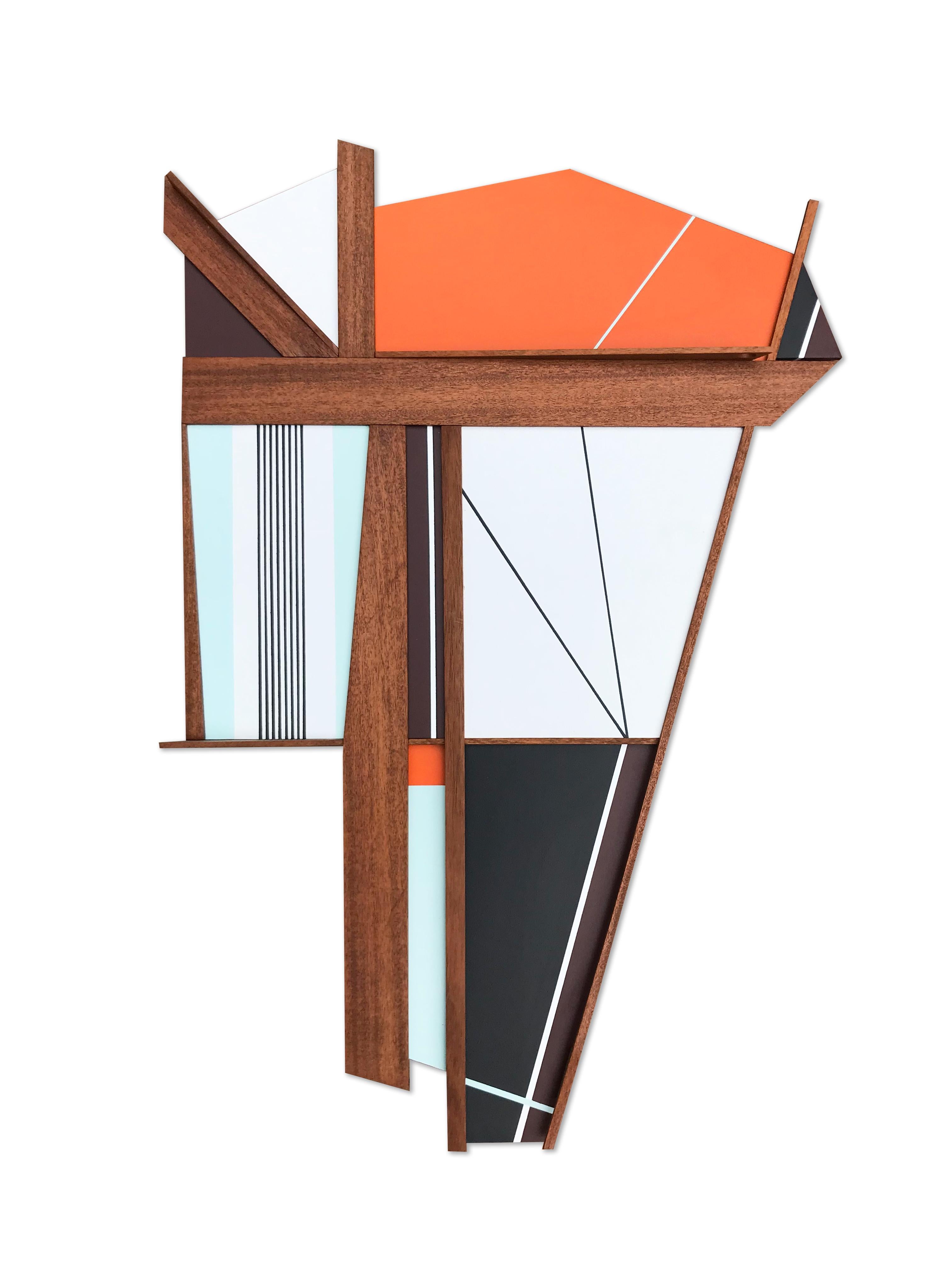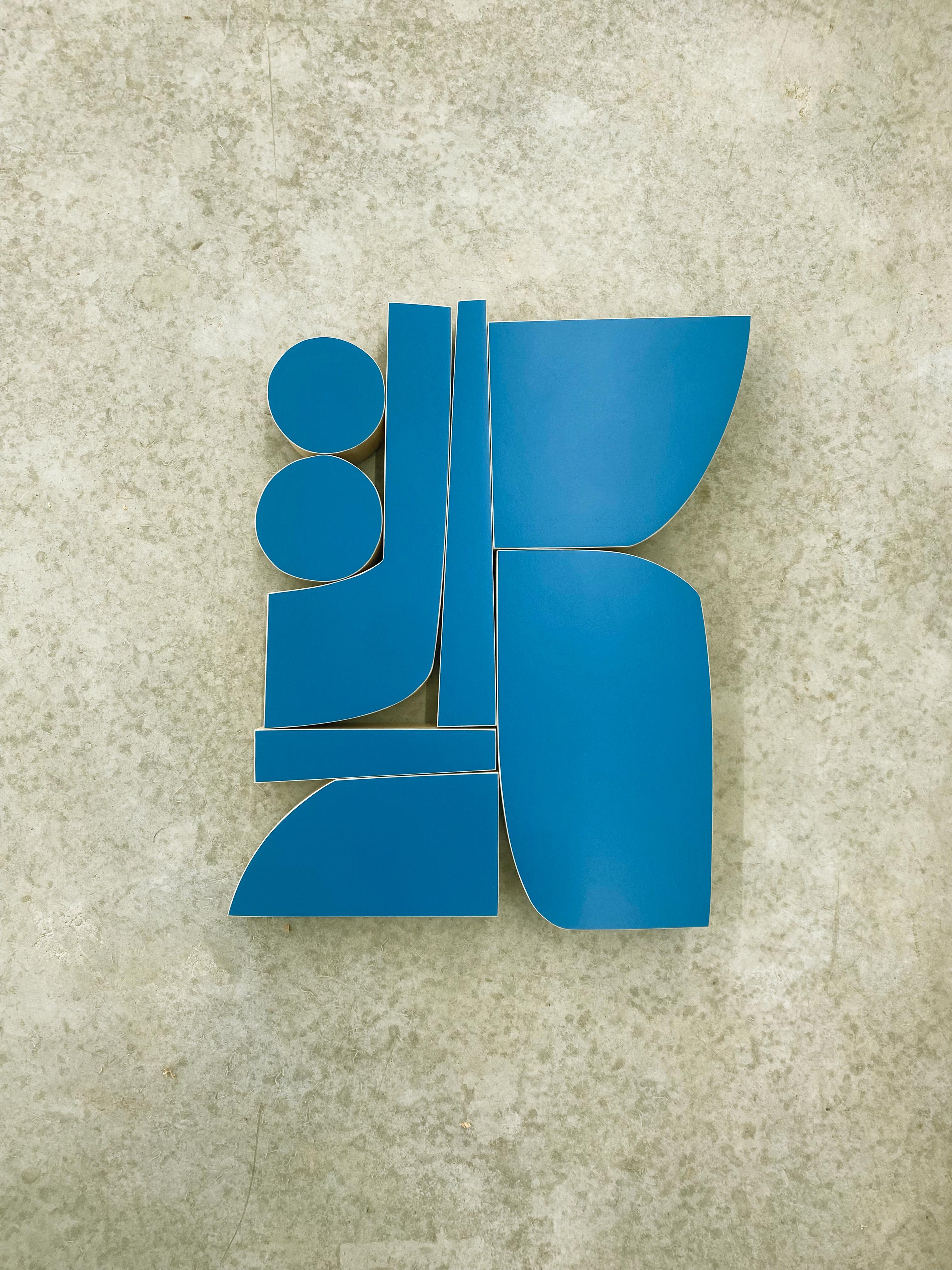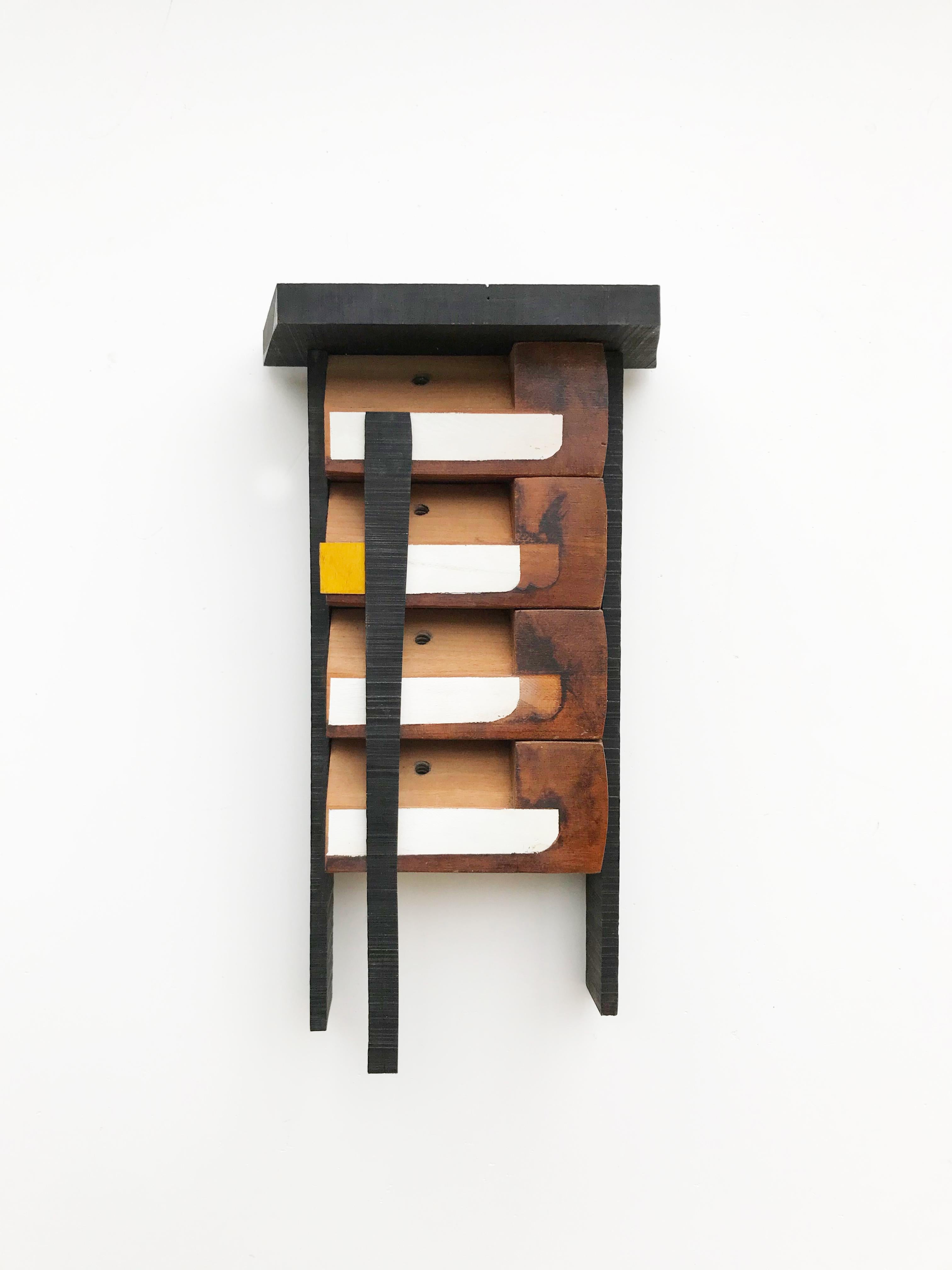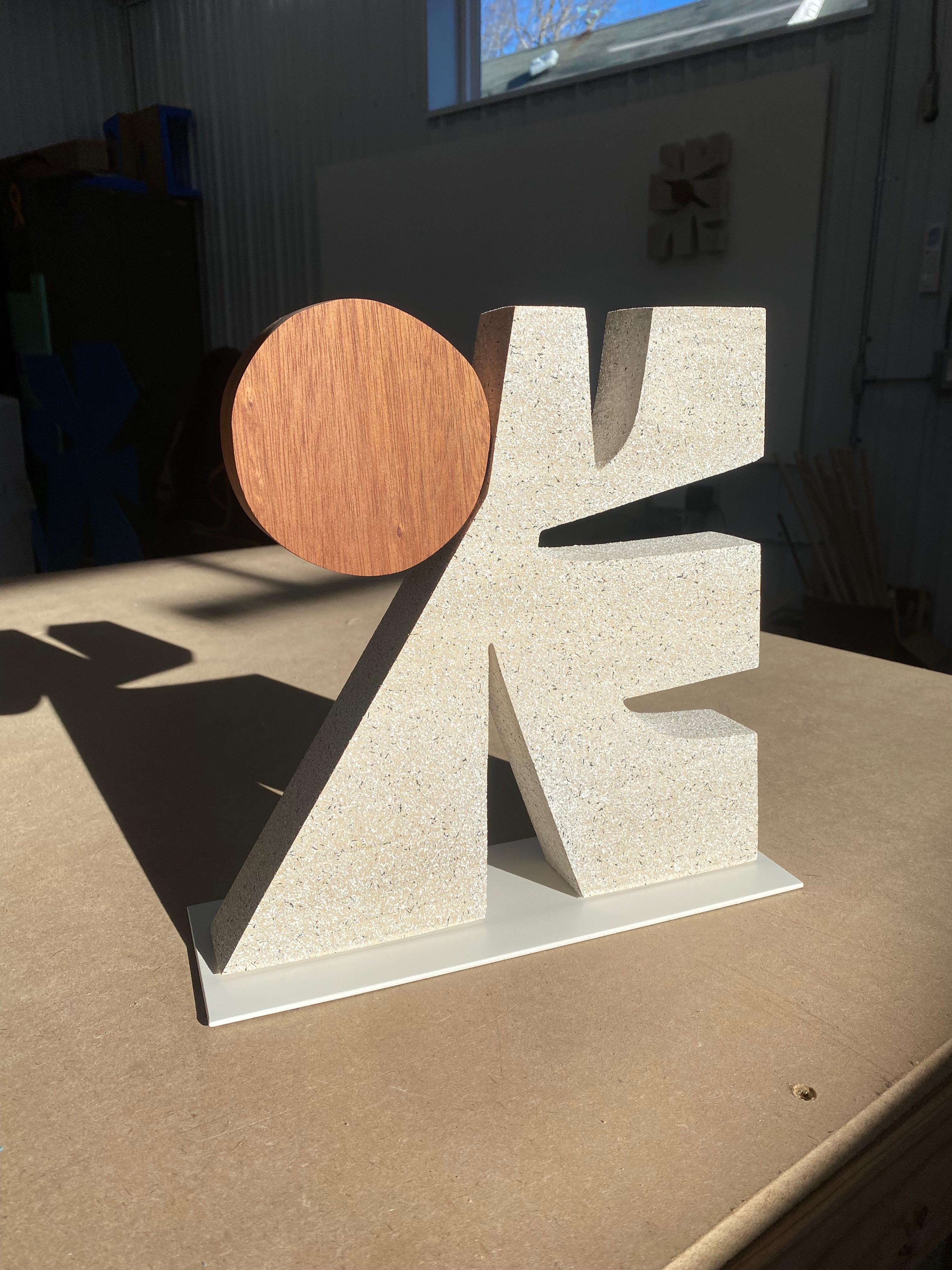Items Similar to "White Construction, " 1960s Modern Abstract Wall Sculpture
Want more images or videos?
Request additional images or videos from the seller
1 of 11
Stanley Bate"White Construction, " 1960s Modern Abstract Wall SculptureCirca 1960
Circa 1960
About the Item
This Modern abstract piece by Stanley Bate is a wood panel sculpture that has been painted white. Three-dimensional that are reminiscent of architectural pieces are tightly stacked with one another to create a geometric piece. A white, elevated wooden piece runs through the wall sculpture both horizontally and vertically, dividing it into four quadrants. The wall sculpture is framed in a white thin white floater frame, and the artist has signed an individual, wooden, rectangular part in the bottom of the piece, just above the frame. It is wired and ready to hang on the wall.
Stanley Bate was born on March 26, 1903 in Nashville, Tennessee. The Bates were an established Tennessee family, in fact, Henry’s brother William Bate was the governor of Tennessee from 1883-1887 and a United States Senator from 1887-1905. Stanley studied art at the Watkins Institute in Nashville.
In the 1920’s Bate moved to New York City to study at the Art Students League under Frederick Bridgman. He soon landed a job with Encyclopedia Britannica, and from 1927-1929 served as art editor. From 1929 until his death in 1972, Stanley was a self-employed artist. He taught art classes at both the Art Students League and the Albany Institute of History and Art and brought in extra income by making illustrations for magazines such as “Outdoor Life” and “Popular Science”.
On January 27, 1934 Stanley married Emilie Rossel. Emilie had emigrated from Switzerland to New York in 1923. She found work as a governess to Alfred Vanderbilt and later as an executive secretary for Wall Street investment brokers Kahn, Loeb and Co. Emilie met Stanley in New York in the early 1930’s when she attended one of his art exhibitions with a friend. The couple, who had no children, lived on 34th Street in Manhattan. During this period, Bate was producing and exhibiting his art and joined several artists groups. Stanley and Emilie became part of the New York art scene, dining weekly at the Society of Illustrators Clubhouse.
Stanley Bate’s time in New York was pivotal in the formation of his painting style. He lived in New York during the inception of one of the most important Modern Art movements, one that helped New York replace Paris as the center of avant-garde art. This movement, which was called the New York School of artists, was later known as Abstract Expressionism. It was comprised of a loosely associated group of vanguard artists working in New York City during the 1940s and 1950s. The New York School was not defined by a specific style, but instead reflected a fusion of European Modernism and American social relevancy that was depicted in many individual styles. Influences of Surrealism, Cubism, and Modernism can be found in their work, along with an interest in experimenting with non-traditional materials and methods. American art was in the forefront of international avant-garde for the first time.
Stanley Bate was undoubtedly exposed to the varied styles and techniques that were emerging during the formative years of the New York School. Mark Rothko and Robert Motherwell were formulating their versions of color field paintings. Joseph Cornell was experimenting with assemblages, collage and the use of different types of textured paints. Jackson Pollock was adhering objects such as buttons and coins into his early works, while Louise Nevelson was using found objects. Helen Frankenthaler added sand to her early paintings. The New York School artists were undermining traditional fine art by using mixed media and non-traditional methods.
Stanley Bate absorbed these varied influences and soon his early realistic landscapes and still-lifes were replaced with something entirely new. The influence of Cubism, notably the flat shallow space of the picture plane, is obvious in many of Bate’s paintings. Surrealism is evident in Bate’s use of subjects from myth, primitive art and antiquity, along with the Automatism-like line work in his more linear images. The unfettered experimentation of the New York School is everywhere in Stanley Bate’s work. We see nods to color field, collage, the mixing of textures into paint, mixed media, the inclusion of found objects and thick, luscious impasto.
Bate was prolific and experimented in various media including oil, watercolor, lithography, silk screen, wood cut, drawing, collage, ceramics and sculpture. Bate is considered a true Modernist. His work is largely abstract, but sometimes figures and buildings are discernable. He frequently mixed paint, sand and glue together to achieve a textured surface, and then scraped and scratched through this layer to expose some of the underpainting below. His sculpture, which is often whimsical, also reflects the non-traditional methods of the New York School. Bate pioneered the use of enamel and copper in his work. The sculptures are not carved or modeled as was done in the past, but instead are built using mixed media and new materials.
In addition to the New York School influence, many of Bate’s works exhibit a strong connection to the Spanish school, especially the work of Antonio Tapies and Modesto Cuixart. These artists were both part of an avant-garde group known as Art Informel, the Spanish equivalent of Abstract Expressionism. These artists likewise worked in mixed media and introduced objects and texture into their work. Many of Bate’s subjects and titles relate to Spanish locations and words. It is likely that Stanley spent time in Spain and found inspiration there.
By the early 1940s, Stanley and Emilie had started spending weekends in a barn they purchased in Craryville, New York, a few hours north of Manhattan. The barn had no electricity or plumbing, but when the Bates eventually decided to leave New York and live full time in Craryville, they remodeled the barn, putting a gallery downstairs and a studio and living quarters upstairs. Although the Bates moved out of New York City, Stanley remained part of the New York art scene, exhibiting in New York and elsewhere throughout the 50s and 60s. During his lifetime he was represented by the New York galleries Knoedler and Company, Kennedy Galleries, Rose Fried Gallery and Key Gallery, along with Tyringham Gallery located in Tyringham, Massachusetts. Craryville was Stanley’s home until his death on August 21, 1972. Emilie died 1984. Her obituary requested that any donations to be made to the Albany Institute of History and Art. The Institute held a retrospective exhibition of Bate’s work in 1973. Since his death, Stanley Bate’s artwork has been exhibited widely and placed in numerous collections.
- Creator:Stanley Bate (1903 - 1972, American)
- Creation Year:Circa 1960
- Dimensions:Height: 37.5 in (95.25 cm)Width: 25.5 in (64.77 cm)Depth: 2 in (5.08 cm)
- Medium:
- Movement & Style:
- Period:
- Condition:Signed by artist. Professionally framed.
- Gallery Location:Westport, CT
- Reference Number:
About the Seller
5.0
Vetted Seller
These experienced sellers undergo a comprehensive evaluation by our team of in-house experts.
Established in 2009
1stDibs seller since 2014
379 sales on 1stDibs
Typical response time: <1 hour
- ShippingRetrieving quote...Ships From: Westport, CT
- Return PolicyThis item cannot be returned.
More From This SellerView All
- "Layers of Sweetness" Abstract PaintingBy Teodora GuererraLocated in Westport, CTThis textured abstract painting by Teodora Guererra features a warm orange and red palette with subtle white accents. The artist applies paint in thick layers and wide, energetic str...Category
2010s Abstract Abstract Paintings
MaterialsCanvas, Oil
- "Royal Whip" Abstract PaintingBy Teodora GuererraLocated in Westport, CTThis textured abstract painting by Teodora Guererra features a deep, royal violet palette with subtle white and magenta accents. The artist applies paint in thick layers and wide, en...Category
2010s Abstract Abstract Paintings
MaterialsCanvas, Oil
- "Strawberry Shortcake Whip I & II" Textured Abstract PaintingBy Teodora GuererraLocated in Westport, CTThis pair of textured abstract paintings by Teodora Guererra features a warm neutral palette with varying tones of muted blush and coral with white and warm grey. The artist uses a p...Category
2010s Abstract Abstract Paintings
MaterialsAcrylic, Board
- "Plum Neutral I & II " A Pair of Textured Abstract PaintingsBy Teodora GuererraLocated in Westport, CTThis pair of textured abstract paintings by Teodora Guererra features a light, greyscale palette with subtle warm accents throughout the composition. The artist layers thick strokes ...Category
2010s Abstract Abstract Paintings
MaterialsAcrylic, Board
- "No Place Like Chrome" Metallic Abstract PaintingBy Teodora GuererraLocated in Westport, CTThis abstract painting by Teodora Guererra features a metallic silver palette. The paint is layered thickly on canvas in wide, gestural strokes, creating a highly textured surface. I...Category
2010s Abstract Abstract Paintings
MaterialsCanvas, Acrylic
- "#OrangeSherbert" Abstract PaintingBy Teodora GuererraLocated in Westport, CTThis abstract painting by Teodora Guererra features a light blue, white, and muted yellow palette. The artist applies layers of paint in sweeping, horizontal gestures to create a thi...Category
2010s Abstract Abstract Paintings
MaterialsCanvas, Acrylic
You May Also Like
- "Voyager VI" Wall Sculpture Modern, orange, black, white, mcm, mid centuryBy Scott TroxelLocated in Marmora, NJPlease Note: This Listing is for a commission. This piece will be made specifically for you. (Colors and palette changes can be arranged). Voyager VI is a large Mixed Media Wall ...Category
2010s Modern Abstract Sculptures
MaterialsWood, Mahogany, Paint
- "Tuxedo" Wall Sculpture- mid century modern, blue, white, navy, yellow, StellaBy Scott TroxelLocated in Marmora, NJ"Tuxedo" is a minimalist and modernist wood wall sculpture reminiscent of both made century modern forms and the brutalist architectural movement. The piece was inspired by my love ...Category
2010s Modern Abstract Sculptures
MaterialsWood, Paint
- "Soobie" Wood Wall Sculpture- By American Artist Scott TroxelBy Scott TroxelLocated in Marmora, NJ"Soobie" Wood Wall Sculpture from the "Small Pops" Collection- 2024 Pigmented satin lacquer on solid maple wood. Finished on three sides and ready to hang. "Soobie" was my aunt's dog...Category
2010s Modern Abstract Sculptures
MaterialsWood, Paint
- "NavyCitron" Wood Wall Sculpture - navy, gold, lime, yellow, white, walnut, boldBy Scott TroxelLocated in Marmora, NJ"NavyCitron" is a striking mid century modernist inspired wall sculpture made from birch, mdf, solid walnut, metallic gold Venetian plaster paint and acrylic paint. Inspired by the ...Category
2010s Modern Abstract Sculptures
MaterialsWood, Birch, Lacquer, Paint
- "Pagoda" Wall Sculpture -wood, white, yellow, rustic, black, modern, repurposedBy Scott TroxelLocated in Marmora, NJ"Pagoda" is a modern rustic wall sculpture. It was made in a similar fashion to an abstract expressionist painting, where the process of creating the piece is not predetermined, but ...Category
2010s Modern Abstract Sculptures
MaterialsWood, Birch, Paint
- "Makaha" (Wood) Desktop Sculpture mid century modern, modernism, monochromeBy Scott TroxelLocated in Marmora, NJ"Makaha (Wood)" is a minimalist and modernist, solid wood freestanding sculpture that brings bold statement to wherever it is placed. Artist Scott Troxel says "The piece is part of...Category
2010s Modern Abstract Sculptures
MaterialsWood, Paint
Recently Viewed
View AllMore Ways To Browse
Period Sculpture
Mixing Vintage With Modern
Mixing Modern With Vintage
Modern Wooden Sculpture
Wooden Modern Sculptures
Painted Wood Construction
1960S Wood Sculptures
Rectangular Sculpture
Rectangular Sculptures
Modern Copper Sculpture
Modernism Sculpture
Modern 21s
Carved Wood Sculpture Abstract
Vintage Wire Sculpture
60s Sculpture
Stack Sculpture
Stackable Sculpture
Stacked Sculpture





